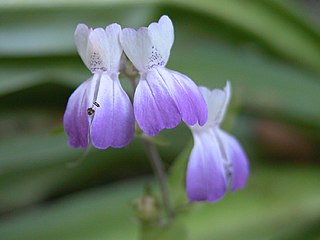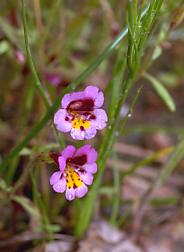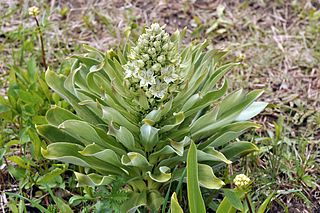
Triteleia ixioides, known as prettyface or golden star, is a monocotyledon flowering plant in the genus Triteleia. It is native to northern and central California and southwestern Oregon, where it can be found in coastal and inland coniferous forests and other habitat. It is a perennial wildflower growing from a corm. It produces one to two basal leaves up to 50 centimeters long by 1.5 wide. The inflorescence arises on an erect stem up to 80 centimeters tall. It is an umbel-like cluster of several flowers each borne on a pedicel up to 7 centimeters long. The flowers are variable in size, measuring one to nearly three centimeters in length. They are pale to bright yellow, or sometimes purple-tinged white. There are six tepals with darker midveins in shades of green, brown, or purple. The lobes are funnel-shaped and may open flat or somewhat reflexed. The six stamens form a fused tube that protrudes from the corolla; they have broad, flat filaments and whitish, yellowish, or blue anthers.
Delphinium decorum is a species of larkspur known by the common names coastal larkspur and yellow-tinge larkspur. This wildflower is native to California and Oregon, where it grows on the slopes of the coastal ranges from the San Francisco Bay Area north to the southern Oregon coast. It has an erect stem which approaches half a meter in height at maximum. The leaves, which are divided into a number of narrow lobes, are mostly located about the base of the plant. The spindly stem above bears two to twenty widely spaced flowers. Each flower is carried on a pedicel several centimeters long. The five long, flat sepals are extended to give the face of the flower a star shape, and they are usually deep blue to purple. The petals are similar in color, except the top two may be lighter to almost white. The spur is very thin and may be nearly two centimeters long.

Gentianopsis holopetala is a species of flowering plant in the gentian family known by the common names Sierra fringed gentian or just "Sierra gentian"'. It is native to the Sierra Nevada and adjacent mountains in California and Nevada, in wet meadows from 6000 to 11,000 ft in elevation. This is an annual or perennial herb, growing stems which may be anywhere from a few centimeters long to nearly half a meter, and may lay along the ground or grow erect. Its small oval or spoon-shaped leaves are mostly basal but may grow sparsely further along the stem.

Gilia brecciarum is an annual flowering plant in the phlox family (Polemoniaceae), known by the common name Nevada gilia or break gilia.

Androsace occidentalis is a species of flowering plant in the primrose family known by the common name western rockjasmine.
Collinsia linearis is a species of flowering plant in the plantain family known by the common name narrowleaf blue-eyed Mary.

Collinsia multicolor is a species of flowering plant in the plantain family, known by the common names San Francisco blue eyed Mary and San Francisco collinsia. It is endemic to the San Francisco Bay Area, where it is known from San Francisco to Santa Cruz. As of 2008 there are 22 known occurrences. Populations south of Santa Cruz have been extirpated.

Collinsia torreyi is a species of flowering plant in the plantain family known by the common name Torrey's blue-eyed Mary. It is native to California and adjacent sections of Oregon and Nevada, where it grows in the coniferous forests of several mountain ranges, including the Sierra Nevada.

Gilia aliquanta is a species of flowering plant in the phlox family known by the common name puffcalyx gilia. It is native to the Sierra Nevada mountains and deserts of southeastern California and southern Nevada.

Erythranthe filicaulis, known by the common name slender-stemmed monkeyflower, is a species of monkeyflower. It was formerly known as Mimulus filicaulis.

Nemacladus glanduliferus is a species of flowering plant in the bellflower family known by the common name glandular threadplant. It is native to the southwestern United States and Baja California, where it grows in desert and plateau habitat. It is an annual herb producing a purplish or brownish green, branching stem up to about 25 centimeters tall. Small oval leaves occur at the base of the plant. The inflorescence is a series of zigzagging branches bearing occasional flowers on thin, erect pedicels. There is a single small bract at the base of each pedicel. The flower at the curved tip of the pedicel is just a few millimeters wide. There are five pointed sepals and five white corolla lobes, generally three in the upper lip and two in the lower.

Nemacladus rigidus is a species of flowering plant in the bellflower family known by the common name stoutstem threadplant. It is native to the Great Basin in the United States, where it grows in open areas, often on bare soil. It is a small annual herb producing a thin, spreading purplish stem no more than 9 centimeters long. Oval leaves up to a centimeter long occur at the base of the plant. The inflorescence is a series of zigzagging branches bearing flowers on thin, curving pedicels. There is a single tiny bract at the base of each pedicel. The flower is under 2 millimeters long. It has five red-veined white or purple-tinged lobes.
Nemophila pulchella, known by the common name Eastwood's baby blue-eyes, is a species of flowering plant in the borage family. It is endemic to California, where it is found from the San Francisco Bay Area to the southern Sierra Nevada to the Transverse Ranges. It grows in many types of mountain, foothill, and valley habitats.

Romanzoffia sitchensis is a species of flowering plant in the borage family known by the common name Sitka mistmaiden. It is native to western North America from Alaska through British Columbia and Alberta to far northern California and Montana.
Frasera puberulenta is a species of flowering plant in the gentian family known by the common name Inyo frasera.

Frasera speciosa is a species of flowering plant in the gentian family (Gentianaceae) known by the common names elkweed, deer's ears, and monument plant.
Tripterocalyx crux-maltae is a species of flowering plant in the four o'clock family known by the common names Lassen sandverbena and Kellogg's sand-verbena.

Veronica cusickii is a species of flowering plant in the plantain family known by the common name Cusick's speedwell. It is native to western North America from British Columbia to Montana to northern California, where it occurs in mountain meadows and forests.
Gilia yorkii is a rare species of flowering plant in the phlox family known by the common names Boyden Cave gilia and monarch gilia. It is endemic to Fresno County, California, where it is known from only one location in the southern Sierra Nevada. This plant grows in rock cracks in the limestone cliffs and outcrops in the chaparral and woodlands of the canyon.

Agalinis paupercula, commonly known as the smallflower false foxglove, is a hemiparasitic annual plant native to the eastern parts of the United States and Canada. Found in open, moist areas, its purple flowers are borne on a 30-to-70-centimeter stem, and bloom in August and September. The species has often been treated as a variety of Agalinis purpurea, the purple false foxglove, and preliminary genetic evidence suggests that the two are, in fact, a single species.













